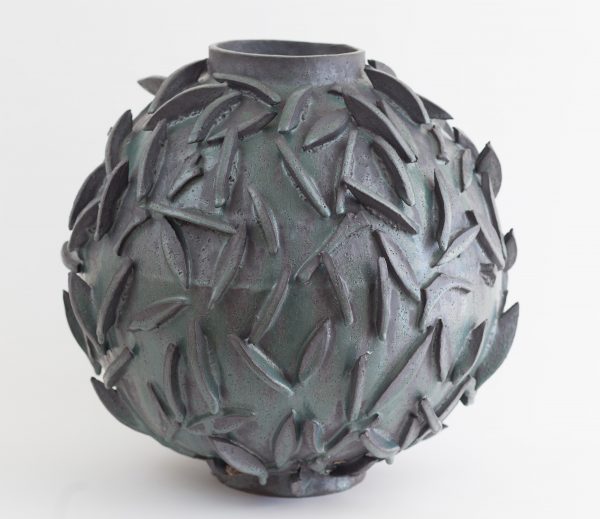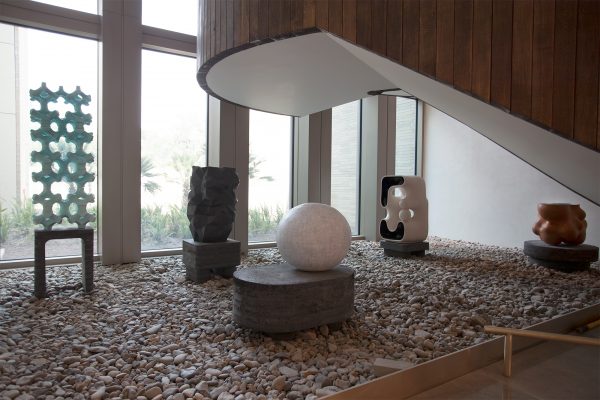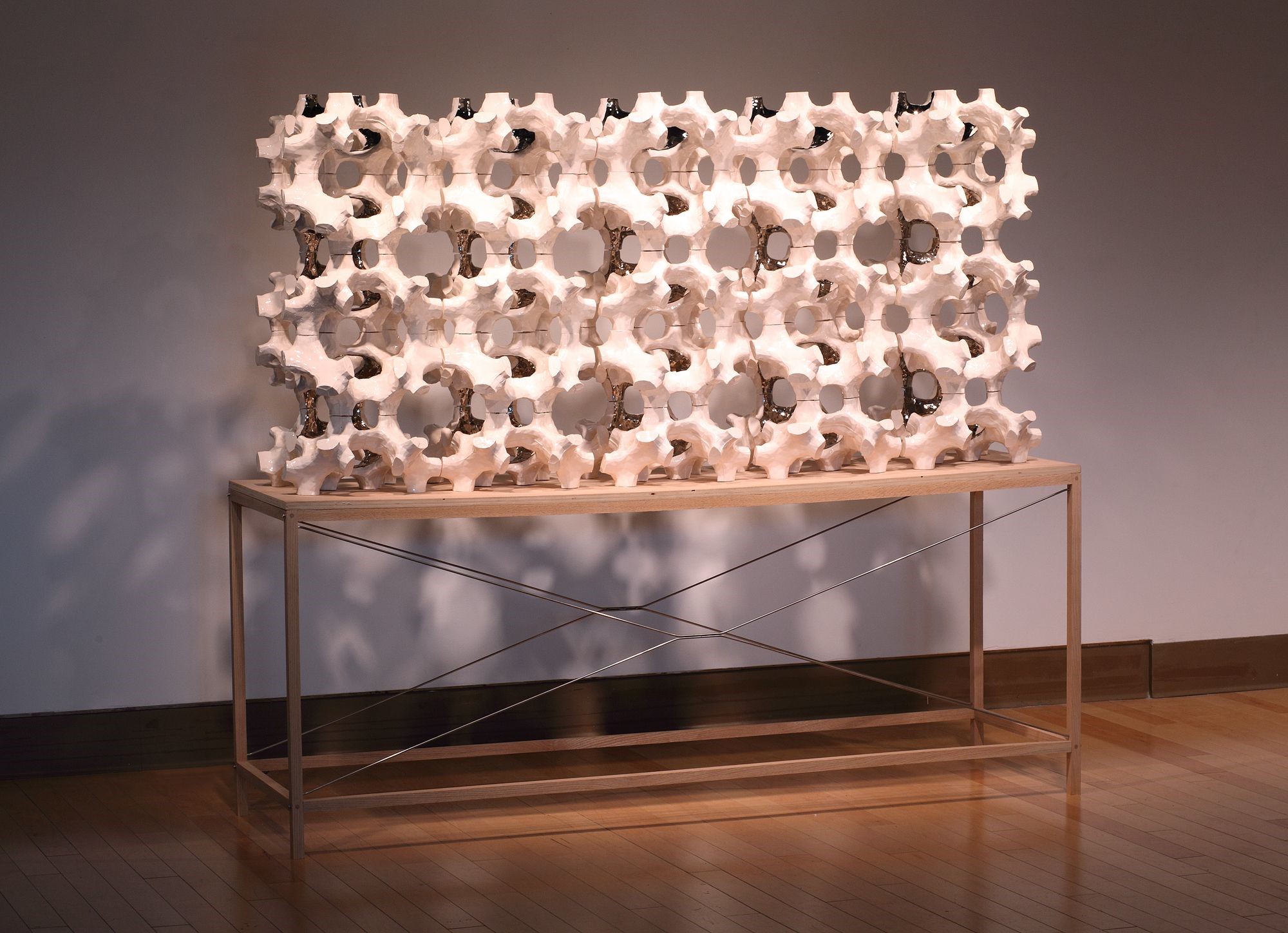Del Harrow, “Breath” (Installation View at Haw Contemporary Gallery, Kansas City, MO)
2014, hand built and glazed earthenware and slip cast porcelain
What role does technology have in art? How do contemporary students view the changing role of technology in their lives and art making? These are some of the questions that associate professor of pottery Del Harrow considers when he approaches creating art.
When asked to describe his work, Harrow explains, “The potter Hamada Shoji said that a good bowl should be larger on the inside than the outside. My work is an ongoing exploration of the possibility that a tactile physical form might contain an expansive interior, a generous space, a site for the imagination and the thinking of thoughts, both intimate and immense. I’m interested in objects with interiors and also the spaces between them. Still lives, diagrams, molecules, tilings, and aggregations each that demonstrate the possibility of arrangements; both complex and organized, formal and narrative, abstract and personal.”
The use of materials in Harrow’s artwork is thoughtful and has developed over time. He selects materials for their individual properties and for the way they perform as parts of a larger system: aluminum for its lightness and sheen, clay for its mutability of form and color, wood for its warmth and flexibility.
Harrow uses a combination of old media and new media, from direct hand-building with coils and slabs of clay to computer-aided design, parametric modelling, and computer-controlled machines for fabrication. “This way of working demands a continuous movement between the abstract and the concrete, between information and manual skill,” he says.
The role of technology is evident in his work, but so is the human touch. This marriage of technology and craft was established in Harrow’s youth.


Studio Practice
“My father spent most of his career as a Birkenstock shoe repairman, but he also worked with clay and had a degree in art education,” Harrow recounts. “My mother went to school for mathematics but switched to computer science and eventually became a software engineer.” Harrow explains that his father led him and his brother in projects using their hands and would engage them in conversations about materials and creativity. At the same time, he observed that his mother was very analytical and systems-based, using an abstract lens to interpret the world. Harrow contends that those two ways of thinking inform his approach to making today.
Harrow’s interest in clay began in high school. He explains that the physicality of working with the clay, the need to focus and concentrate on centering the clay on the potter’s wheel permitted the opportunity to tune out everything else and reach a sense of calm. “I just felt good after working with the clay; it was so profoundly therapeutic for me as a teenager.”
Later, just before graduate school, Harrow recognized that his systematic, structural approach to making physical forms was certainty the influence of his mother, but it also led to his curiosity with technology. “I became interested in building ceramics kilns and at the same time computer-aided design software was becoming more available. I considered how the software could assist with the design of the kilns I was building; determining how many bricks you need to make an arch or what the form of a catenary arch would look like, for example,” he says.
From that point on, Harrow recognized that the structural, systematic approach to ordering found in design software fit his method of thinking and making and could be applied in other ways to ceramic materials. Of using technology in combination with process, Harrow says, “individual objects emerge from a confluence of form, material, and process. Many sculptures begin as digital models—employing computer software as a tool for generating abstract form. As material culture, an object’s subtle textures and marks contain and reveal information about methods of fabrication—manual or mechanized production—and by extension the scale of economy, culture, and the object’s meaning within it.”

Technology and Clay
‘What is the relationship between technology and clay?’ Such a question begs philosophical considerations, according to Harrow. He explains, “many people might consider technology as recent inventions or innovations, instruments that make our lives comfortable—clean and efficient. Clay, on the other hand, might be considered the anthesis of that—it is about mud and dirt. It’s as if these approaches operate as binary oppositions.” But Harrow proposes that this discussion can be observed from another point of view.
“Technology has always been fundamental to the crafts. Any craft is rooted in the use of some tool. In ceramics that can be the potter’s wheel or kiln. It comes back to limiting our definition of technology to new inventions. Technology is inherent to human history, to human practice. They might be old technologies, but they are still technologies.”
These notions lead Harrow back to the essential question of what is technology? “If we go back to its etymological roots and consider the Greek root tekhne— 'an art, skill, craft in work; method, system, an art, a system or method of making or doing' —technology becomes about systematizing, standardizing, and organizing. It’s not necessarily about an external or physical instrument but about skills or physical practices involved in making. And this brings us back to that work of throwing on the wheel!” he says. Throwing on the wheel, as Harrow points out, is about practice and a development of skill, repetition of movements, involvement in a kind of ritual practice.

In the article “Towards an Aesthetic of Digital Clay,” co-authored with colleague Andy Brayman, Harrow considered this very discussion.
Our interest in this technology goes beyond the straightforward functional outcomes of precision, speed, and scalability that we often associate with digital technology. We are interested in exploring the particular formal possibilities and aesthetic qualities made possible through new and varied techniques. From this point of view, the answer to this question may be surprisingly similar to another: Why should artists continue to make things by hand? If we assume, as David Pye predicted, that through the use of digital fabrication technology we'll soon be able to achieve any level of variety and complexity in material culture, what is the use of continuing to make things that explore the workmanship of risk?
It seems evident, especially to those trained and experienced in making by hand, that the way we work and make affects the way we think. Beyond the short-term goals of achieving formal effects and variety in material culture, the process of making deeply shapes the cognitive experience of the maker. If this is true, then what we are striving for in the studio, through the use of new and hybrid technologies, is a deeper kind of variety. Beyond the immediate effect of production processes on material culture, we aim for variety in the ways we think about making and the ways in which making is thinking. We believe that this variety will ultimately contribute to a deeper and long-term variety in the pots we make and the world we build.
